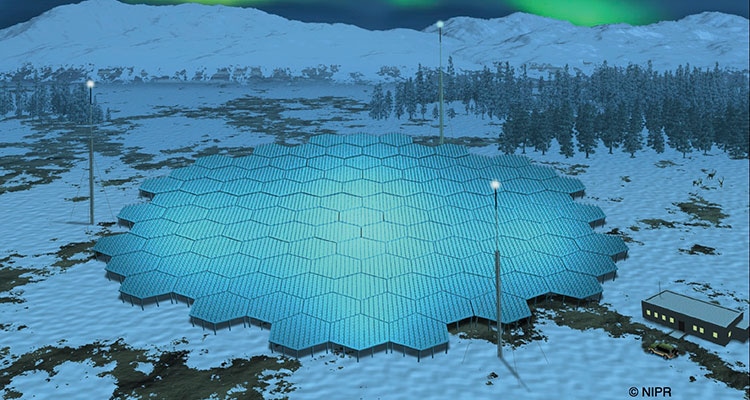Aug 24 2017
Efforts are on to construct the world’s most ultramodern space weather radar in the Arctic, which involves an international collaboration including the UK. The endeavor has been powered by new investments of nearly 4 to 6 million pounds on the part of NERC.
 An artist's impression of what EISCAT_3D's central radar site will look like (based at Skibotn, near Tromsø in Norway). Credit: NERC
An artist's impression of what EISCAT_3D's central radar site will look like (based at Skibotn, near Tromsø in Norway). Credit: NERC
The EISCAT_3D radar will prove to be an avant-garde tool that would assist UK Researchers in examining the near-Earth space and upper atmosphere, thereby enabling them to have an in-depth knowledge of the impact of space weather storms on society, technology and the environment.
Space weather has been included in the National Risk Register by the UK government due to its potential to damage communications, satellites, as well as power grids. Solar storms steer space weather; however, the huge challenge faced in space weather science is enhancing our knowledge on the response of the Earth’s atmosphere and magnetic field to the event. EISCAT_3D will enable Researchers to gain knowledge of these associations.
To be built at an expenditure of 63 million pounds, the equipment will cover three sites in northern Scandinavia, namely, in Skibotn in Norway, near Kiruna in Sweden and near Kaaresuvanto in Finland. The construction will begin in September 2017 and site preparations will start in summer 2018. It is anticipated that the EISCAT_3D radar will be functional by the year 2021.
One of the main potentials of the radar will be the detailed measurement of a complete 3D volume of the upper atmosphere in an unparalleled manner. This will be crucial in having an in-depth knowledge on the impact of electrical currents and energetic particles from space on the lower and upper atmosphere. The equipment will enable Researchers to measure across the scales of hundreds of meters to hundreds of kilometers, thereby offering huge amount of data with remarkable detail, and also widening the scope for further research.
A number of EISCAT radars have already been commissioned in the northern hemisphere in the well-known auroral oval, that is, area in which one can view the northern lights, or aurora borealis. These radars perform measurements in the ionosphere region of the upper atmosphere of Earth, that is, at an altitude of 70-1000 km. They evaluate not only the ion temperature and velocity but also the electron concentration and temperature at a broad array of altitudes across the direction of the radar beam. However, only a single pencil beam is offered by the prevalent EISCAT radars, hence Scientists will be able to investigate only a small portion of the sky at a given point in time.
The new EISCAT_3D radar will measure the ionosphere in lots of different directions simultaneously. It will be like having hundreds of dishes all operating together, looking in different directions. This means we can easily see changes in the ionosphere and don’t miss important data: when our measurements change we will be able to say whether something had just appeared or faded or if something was moving through the beams. This is really important as it gives us information about how space weather effects evolve.
Dr Andrew Kavanagh, UK EISCAT Science Support
In Skibotn in Norway, transmitter and receiver arrays will be built. In contrast, only receiver arrays will be built in Kiruna and in Kaaresuvanto. These will produce beams with the ability to “look into” the transmitted beam and provide numerous intersection heights to the Scientists.
EISCAT_3D will give us a 3D picture of interactions between space weather and our upper atmosphere with a detail we’ve not seen before, giving us answers to questions researchers have about the impacts of space weather on the upper atmosphere. We need this information to reduce the risks posed by space weather on our communications systems, satellites and power grids, which we all rely on.
Professor Duncan Wingham, Chief Executive, NERC
Dr Craig Heinselman, EISCAT Director, stated, “We are very excited to be starting construction of the new EISCAT_3D radar system. Building on over three and a half decades of scientific observations with the legacy EISCAT radars, this new multi-site phased-array radar will allow our international user community to investigate important questions about the physics of the near-Earth space environment. The radar will make measurements at least ten times faster and with ten times finer resolution than current systems. It will also provide fundamentally different measurements which are unique in the scientific world by utilising, initially, fully flexible receive arrays at two separated locations in the Nordic region in concert with the core transmit/receive array.”
“These systems will let us probe phenomena such as the aurora borealis in three dimensions and, in concert with a variety of other measurements, will allow us to uncover the fundamental effects of phenomena such as space weather. EISCAT_3D uses modern analog and digital technologies that enable flexibility now and a path forward for implementing new ideas that emerge from future discoveries. It truly represents a platform for the next generation of space scientists to build upon.”